Analysis of Financial Statements for Investment Decisions
VerifiedAdded on 2020/05/08
|8
|1463
|50
AI Summary
The assignment delves into the significance of Vodafone Group Plc's financial statements for diverse stakeholders such as governments, investors, competitors, and financial institutions, demonstrating how they use this information for decision-making. It highlights Vodafone’s strong corporate governance and compliance with international accounting standards like IFRS and GAAP. The analysis underscores the company’s strategic moves in expanding its customer base and entering new markets, which are crucial for stakeholders interested in the company's competitive position and growth prospects. Additionally, it discusses the impact of regulatory requirements on financial reporting, emphasizing the need for uniformity in accounting practices to enhance transparency and comparability across borders.

FINANCE & ACCOUNTING ASSIGNMENT
Paraphrase This Document
Need a fresh take? Get an instant paraphrase of this document with our AI Paraphraser
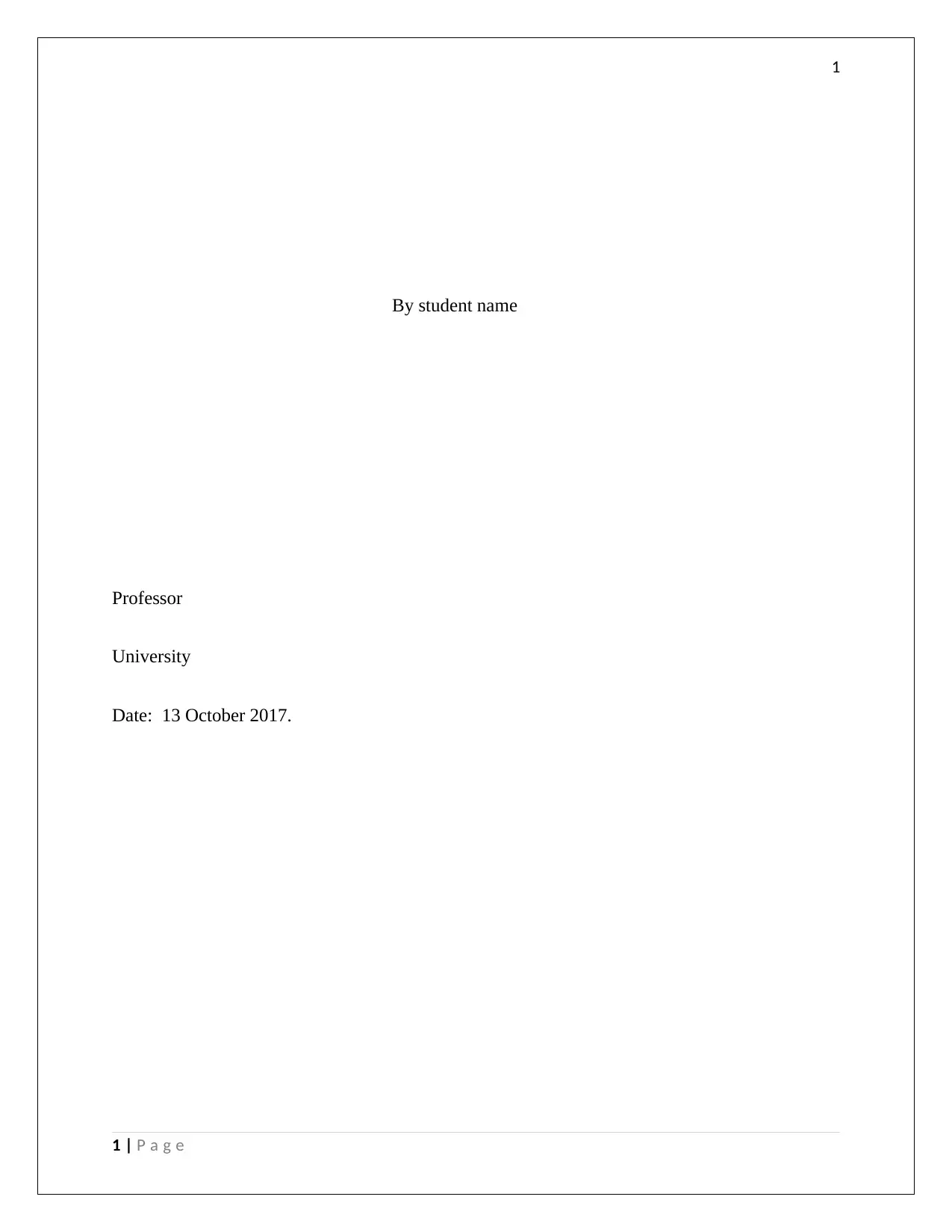
1
By student name
Professor
University
Date: 13 October 2017.
1 | P a g e
By student name
Professor
University
Date: 13 October 2017.
1 | P a g e
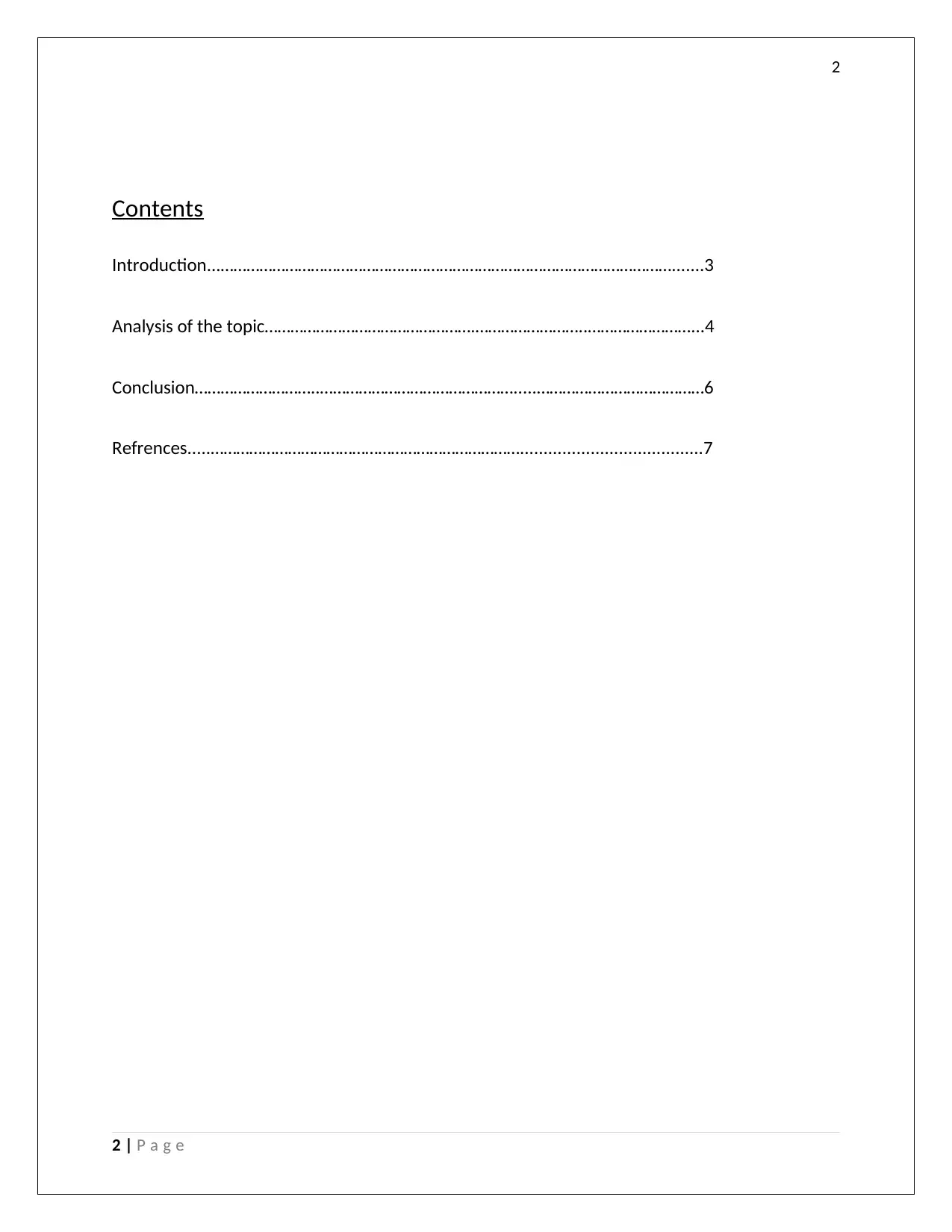
2
Contents
Introduction...…………………………………………………………………………………………….......3
Analysis of the topic………………………………………….……………………..……………………...4
Conclusion………………………..……………………………………….....…………………………………6
Refrences.....……………………………………………………………….......................................7
2 | P a g e
Contents
Introduction...…………………………………………………………………………………………….......3
Analysis of the topic………………………………………….……………………..……………………...4
Conclusion………………………..……………………………………….....…………………………………6
Refrences.....……………………………………………………………….......................................7
2 | P a g e
⊘ This is a preview!⊘
Do you want full access?
Subscribe today to unlock all pages.

Trusted by 1+ million students worldwide
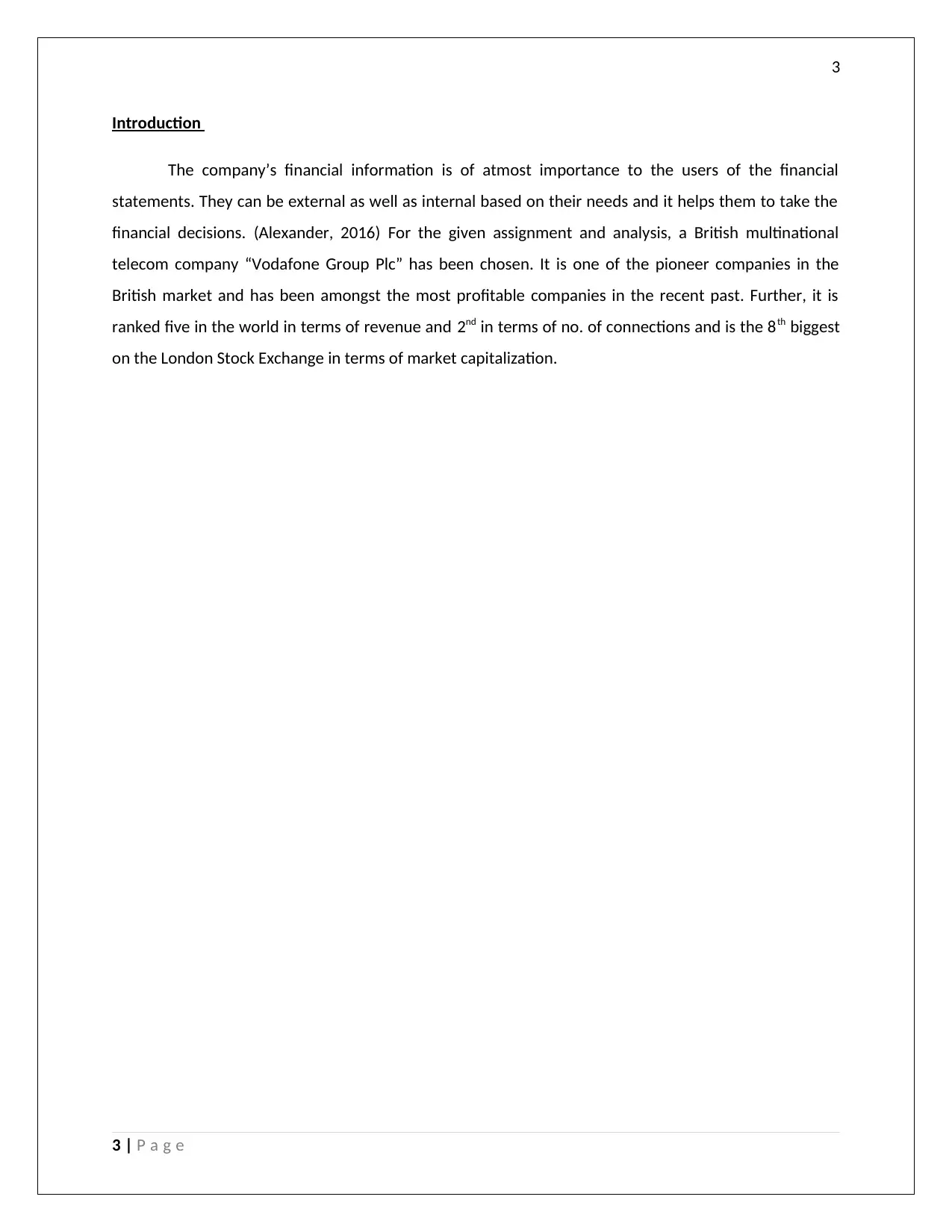
3
Introduction
The company’s financial information is of atmost importance to the users of the financial
statements. They can be external as well as internal based on their needs and it helps them to take the
financial decisions. (Alexander, 2016) For the given assignment and analysis, a British multinational
telecom company “Vodafone Group Plc” has been chosen. It is one of the pioneer companies in the
British market and has been amongst the most profitable companies in the recent past. Further, it is
ranked five in the world in terms of revenue and 2nd in terms of no. of connections and is the 8th biggest
on the London Stock Exchange in terms of market capitalization.
3 | P a g e
Introduction
The company’s financial information is of atmost importance to the users of the financial
statements. They can be external as well as internal based on their needs and it helps them to take the
financial decisions. (Alexander, 2016) For the given assignment and analysis, a British multinational
telecom company “Vodafone Group Plc” has been chosen. It is one of the pioneer companies in the
British market and has been amongst the most profitable companies in the recent past. Further, it is
ranked five in the world in terms of revenue and 2nd in terms of no. of connections and is the 8th biggest
on the London Stock Exchange in terms of market capitalization.
3 | P a g e
Paraphrase This Document
Need a fresh take? Get an instant paraphrase of this document with our AI Paraphraser
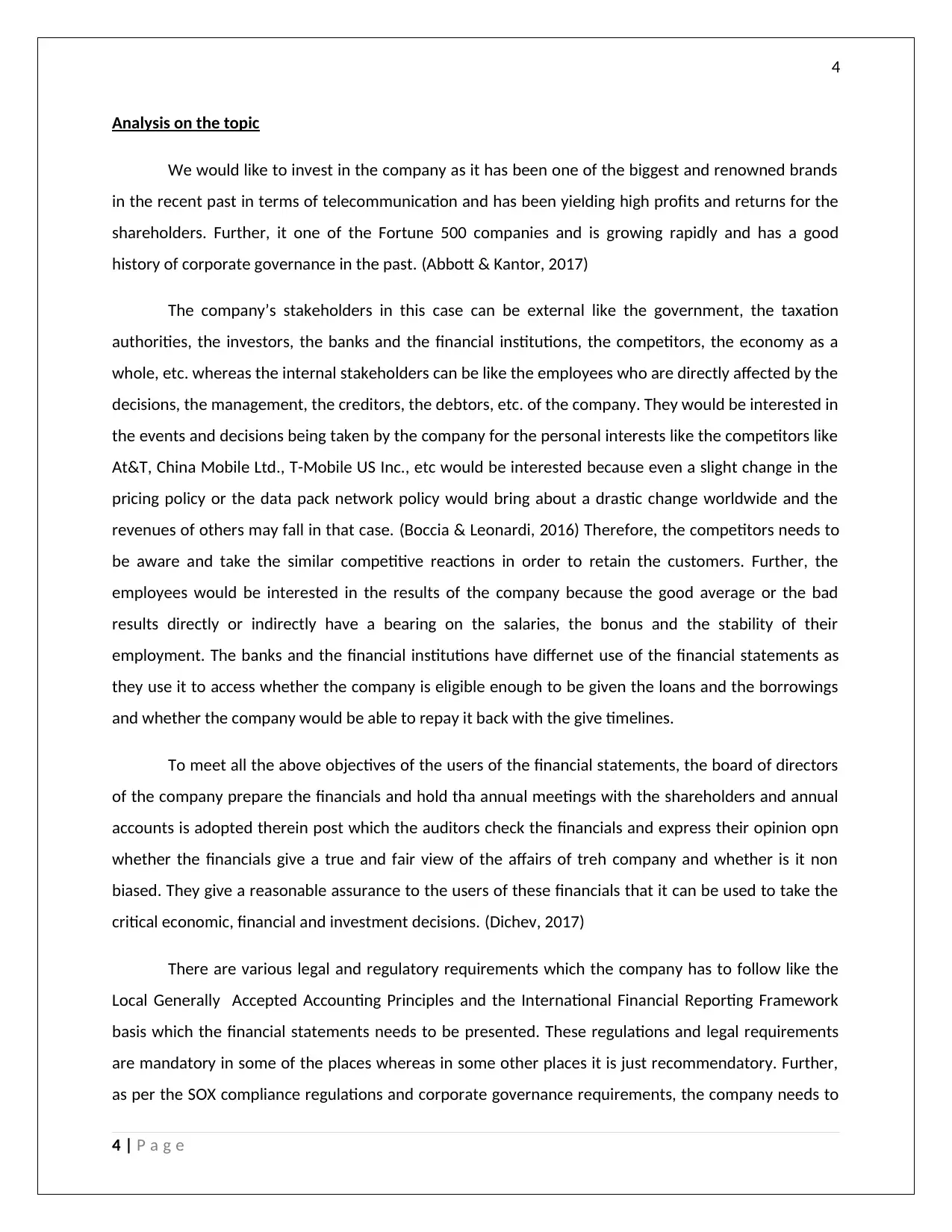
4
Analysis on the topic
We would like to invest in the company as it has been one of the biggest and renowned brands
in the recent past in terms of telecommunication and has been yielding high profits and returns for the
shareholders. Further, it one of the Fortune 500 companies and is growing rapidly and has a good
history of corporate governance in the past. (Abbott & Kantor, 2017)
The company’s stakeholders in this case can be external like the government, the taxation
authorities, the investors, the banks and the financial institutions, the competitors, the economy as a
whole, etc. whereas the internal stakeholders can be like the employees who are directly affected by the
decisions, the management, the creditors, the debtors, etc. of the company. They would be interested in
the events and decisions being taken by the company for the personal interests like the competitors like
At&T, China Mobile Ltd., T-Mobile US Inc., etc would be interested because even a slight change in the
pricing policy or the data pack network policy would bring about a drastic change worldwide and the
revenues of others may fall in that case. (Boccia & Leonardi, 2016) Therefore, the competitors needs to
be aware and take the similar competitive reactions in order to retain the customers. Further, the
employees would be interested in the results of the company because the good average or the bad
results directly or indirectly have a bearing on the salaries, the bonus and the stability of their
employment. The banks and the financial institutions have differnet use of the financial statements as
they use it to access whether the company is eligible enough to be given the loans and the borrowings
and whether the company would be able to repay it back with the give timelines.
To meet all the above objectives of the users of the financial statements, the board of directors
of the company prepare the financials and hold tha annual meetings with the shareholders and annual
accounts is adopted therein post which the auditors check the financials and express their opinion opn
whether the financials give a true and fair view of the affairs of treh company and whether is it non
biased. They give a reasonable assurance to the users of these financials that it can be used to take the
critical economic, financial and investment decisions. (Dichev, 2017)
There are various legal and regulatory requirements which the company has to follow like the
Local Generally Accepted Accounting Principles and the International Financial Reporting Framework
basis which the financial statements needs to be presented. These regulations and legal requirements
are mandatory in some of the places whereas in some other places it is just recommendatory. Further,
as per the SOX compliance regulations and corporate governance requirements, the company needs to
4 | P a g e
Analysis on the topic
We would like to invest in the company as it has been one of the biggest and renowned brands
in the recent past in terms of telecommunication and has been yielding high profits and returns for the
shareholders. Further, it one of the Fortune 500 companies and is growing rapidly and has a good
history of corporate governance in the past. (Abbott & Kantor, 2017)
The company’s stakeholders in this case can be external like the government, the taxation
authorities, the investors, the banks and the financial institutions, the competitors, the economy as a
whole, etc. whereas the internal stakeholders can be like the employees who are directly affected by the
decisions, the management, the creditors, the debtors, etc. of the company. They would be interested in
the events and decisions being taken by the company for the personal interests like the competitors like
At&T, China Mobile Ltd., T-Mobile US Inc., etc would be interested because even a slight change in the
pricing policy or the data pack network policy would bring about a drastic change worldwide and the
revenues of others may fall in that case. (Boccia & Leonardi, 2016) Therefore, the competitors needs to
be aware and take the similar competitive reactions in order to retain the customers. Further, the
employees would be interested in the results of the company because the good average or the bad
results directly or indirectly have a bearing on the salaries, the bonus and the stability of their
employment. The banks and the financial institutions have differnet use of the financial statements as
they use it to access whether the company is eligible enough to be given the loans and the borrowings
and whether the company would be able to repay it back with the give timelines.
To meet all the above objectives of the users of the financial statements, the board of directors
of the company prepare the financials and hold tha annual meetings with the shareholders and annual
accounts is adopted therein post which the auditors check the financials and express their opinion opn
whether the financials give a true and fair view of the affairs of treh company and whether is it non
biased. They give a reasonable assurance to the users of these financials that it can be used to take the
critical economic, financial and investment decisions. (Dichev, 2017)
There are various legal and regulatory requirements which the company has to follow like the
Local Generally Accepted Accounting Principles and the International Financial Reporting Framework
basis which the financial statements needs to be presented. These regulations and legal requirements
are mandatory in some of the places whereas in some other places it is just recommendatory. Further,
as per the SOX compliance regulations and corporate governance requirements, the company needs to
4 | P a g e
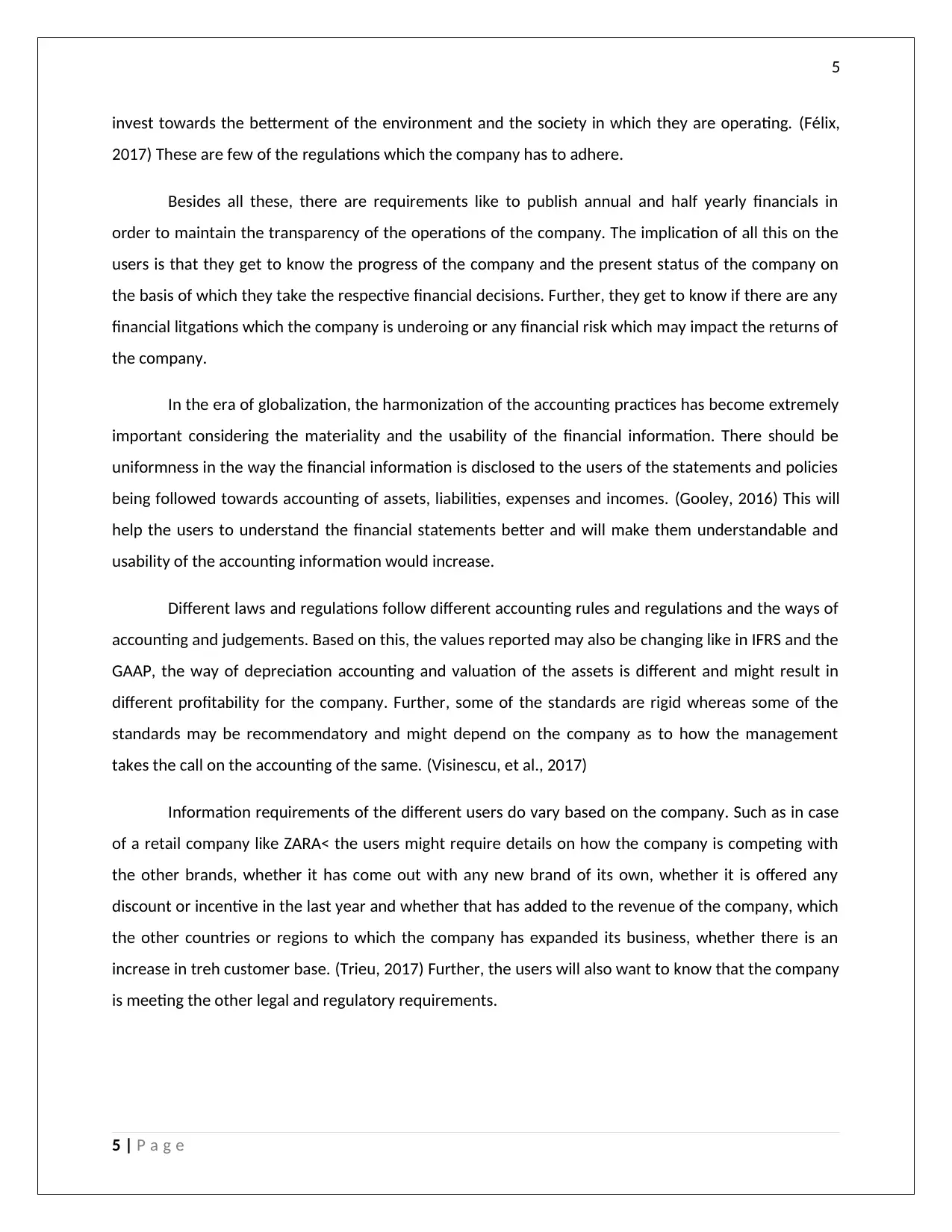
5
invest towards the betterment of the environment and the society in which they are operating. (Félix,
2017) These are few of the regulations which the company has to adhere.
Besides all these, there are requirements like to publish annual and half yearly financials in
order to maintain the transparency of the operations of the company. The implication of all this on the
users is that they get to know the progress of the company and the present status of the company on
the basis of which they take the respective financial decisions. Further, they get to know if there are any
financial litgations which the company is underoing or any financial risk which may impact the returns of
the company.
In the era of globalization, the harmonization of the accounting practices has become extremely
important considering the materiality and the usability of the financial information. There should be
uniformness in the way the financial information is disclosed to the users of the statements and policies
being followed towards accounting of assets, liabilities, expenses and incomes. (Gooley, 2016) This will
help the users to understand the financial statements better and will make them understandable and
usability of the accounting information would increase.
Different laws and regulations follow different accounting rules and regulations and the ways of
accounting and judgements. Based on this, the values reported may also be changing like in IFRS and the
GAAP, the way of depreciation accounting and valuation of the assets is different and might result in
different profitability for the company. Further, some of the standards are rigid whereas some of the
standards may be recommendatory and might depend on the company as to how the management
takes the call on the accounting of the same. (Visinescu, et al., 2017)
Information requirements of the different users do vary based on the company. Such as in case
of a retail company like ZARA< the users might require details on how the company is competing with
the other brands, whether it has come out with any new brand of its own, whether it is offered any
discount or incentive in the last year and whether that has added to the revenue of the company, which
the other countries or regions to which the company has expanded its business, whether there is an
increase in treh customer base. (Trieu, 2017) Further, the users will also want to know that the company
is meeting the other legal and regulatory requirements.
5 | P a g e
invest towards the betterment of the environment and the society in which they are operating. (Félix,
2017) These are few of the regulations which the company has to adhere.
Besides all these, there are requirements like to publish annual and half yearly financials in
order to maintain the transparency of the operations of the company. The implication of all this on the
users is that they get to know the progress of the company and the present status of the company on
the basis of which they take the respective financial decisions. Further, they get to know if there are any
financial litgations which the company is underoing or any financial risk which may impact the returns of
the company.
In the era of globalization, the harmonization of the accounting practices has become extremely
important considering the materiality and the usability of the financial information. There should be
uniformness in the way the financial information is disclosed to the users of the statements and policies
being followed towards accounting of assets, liabilities, expenses and incomes. (Gooley, 2016) This will
help the users to understand the financial statements better and will make them understandable and
usability of the accounting information would increase.
Different laws and regulations follow different accounting rules and regulations and the ways of
accounting and judgements. Based on this, the values reported may also be changing like in IFRS and the
GAAP, the way of depreciation accounting and valuation of the assets is different and might result in
different profitability for the company. Further, some of the standards are rigid whereas some of the
standards may be recommendatory and might depend on the company as to how the management
takes the call on the accounting of the same. (Visinescu, et al., 2017)
Information requirements of the different users do vary based on the company. Such as in case
of a retail company like ZARA< the users might require details on how the company is competing with
the other brands, whether it has come out with any new brand of its own, whether it is offered any
discount or incentive in the last year and whether that has added to the revenue of the company, which
the other countries or regions to which the company has expanded its business, whether there is an
increase in treh customer base. (Trieu, 2017) Further, the users will also want to know that the company
is meeting the other legal and regulatory requirements.
5 | P a g e
⊘ This is a preview!⊘
Do you want full access?
Subscribe today to unlock all pages.

Trusted by 1+ million students worldwide
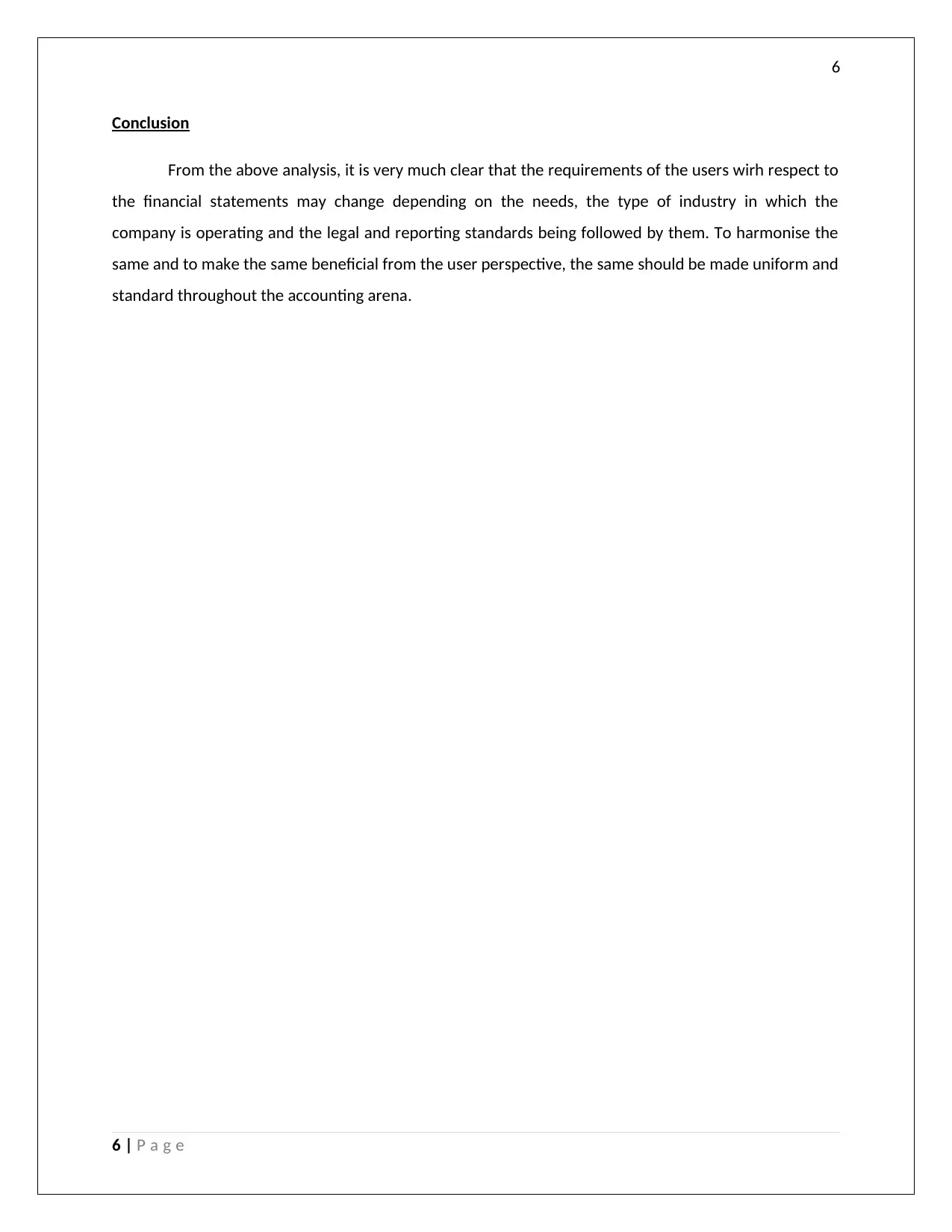
6
Conclusion
From the above analysis, it is very much clear that the requirements of the users wirh respect to
the financial statements may change depending on the needs, the type of industry in which the
company is operating and the legal and reporting standards being followed by them. To harmonise the
same and to make the same beneficial from the user perspective, the same should be made uniform and
standard throughout the accounting arena.
6 | P a g e
Conclusion
From the above analysis, it is very much clear that the requirements of the users wirh respect to
the financial statements may change depending on the needs, the type of industry in which the
company is operating and the legal and reporting standards being followed by them. To harmonise the
same and to make the same beneficial from the user perspective, the same should be made uniform and
standard throughout the accounting arena.
6 | P a g e
Paraphrase This Document
Need a fresh take? Get an instant paraphrase of this document with our AI Paraphraser
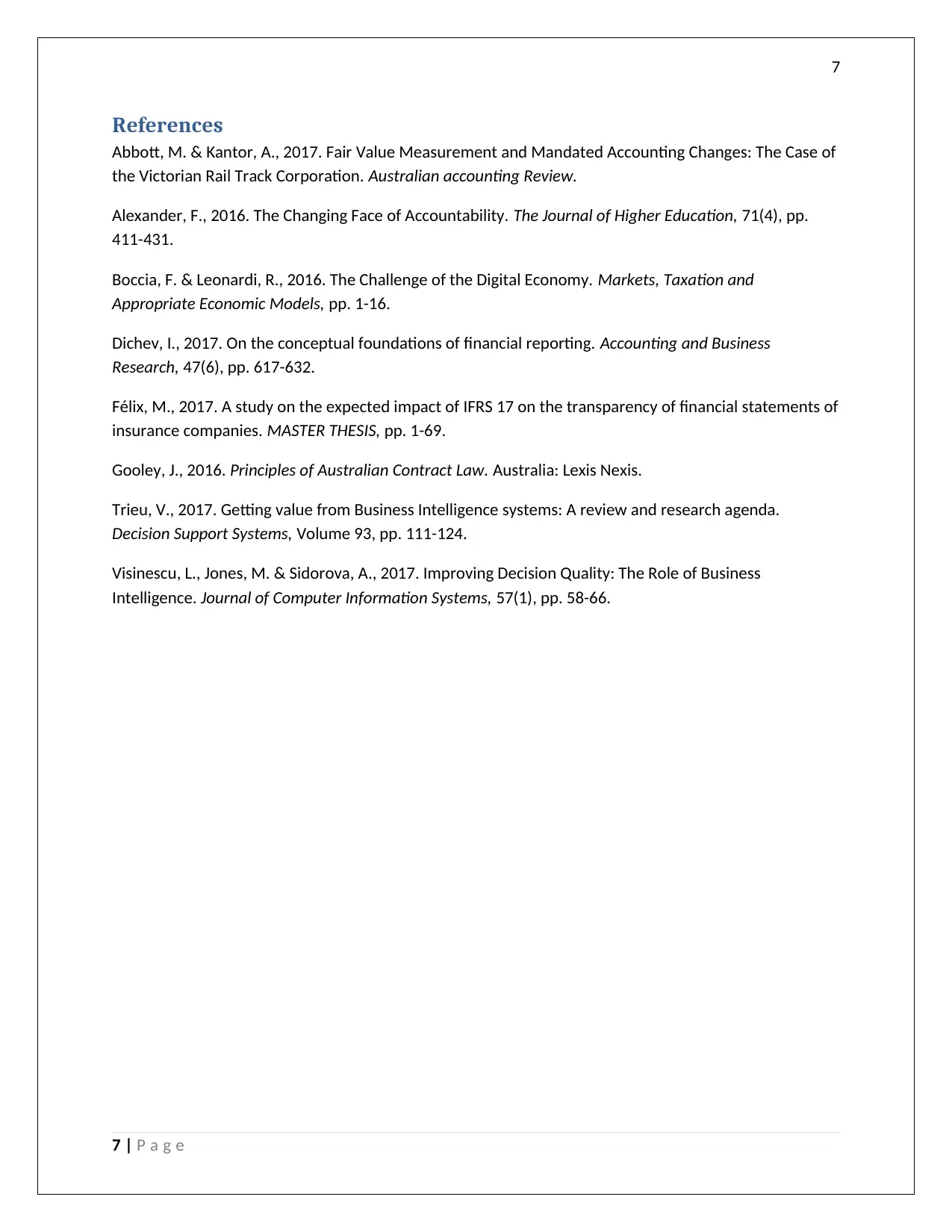
7
References
Abbott, M. & Kantor, A., 2017. Fair Value Measurement and Mandated Accounting Changes: The Case of
the Victorian Rail Track Corporation. Australian accounting Review.
Alexander, F., 2016. The Changing Face of Accountability. The Journal of Higher Education, 71(4), pp.
411-431.
Boccia, F. & Leonardi, R., 2016. The Challenge of the Digital Economy. Markets, Taxation and
Appropriate Economic Models, pp. 1-16.
Dichev, I., 2017. On the conceptual foundations of financial reporting. Accounting and Business
Research, 47(6), pp. 617-632.
Félix, M., 2017. A study on the expected impact of IFRS 17 on the transparency of financial statements of
insurance companies. MASTER THESIS, pp. 1-69.
Gooley, J., 2016. Principles of Australian Contract Law. Australia: Lexis Nexis.
Trieu, V., 2017. Getting value from Business Intelligence systems: A review and research agenda.
Decision Support Systems, Volume 93, pp. 111-124.
Visinescu, L., Jones, M. & Sidorova, A., 2017. Improving Decision Quality: The Role of Business
Intelligence. Journal of Computer Information Systems, 57(1), pp. 58-66.
7 | P a g e
References
Abbott, M. & Kantor, A., 2017. Fair Value Measurement and Mandated Accounting Changes: The Case of
the Victorian Rail Track Corporation. Australian accounting Review.
Alexander, F., 2016. The Changing Face of Accountability. The Journal of Higher Education, 71(4), pp.
411-431.
Boccia, F. & Leonardi, R., 2016. The Challenge of the Digital Economy. Markets, Taxation and
Appropriate Economic Models, pp. 1-16.
Dichev, I., 2017. On the conceptual foundations of financial reporting. Accounting and Business
Research, 47(6), pp. 617-632.
Félix, M., 2017. A study on the expected impact of IFRS 17 on the transparency of financial statements of
insurance companies. MASTER THESIS, pp. 1-69.
Gooley, J., 2016. Principles of Australian Contract Law. Australia: Lexis Nexis.
Trieu, V., 2017. Getting value from Business Intelligence systems: A review and research agenda.
Decision Support Systems, Volume 93, pp. 111-124.
Visinescu, L., Jones, M. & Sidorova, A., 2017. Improving Decision Quality: The Role of Business
Intelligence. Journal of Computer Information Systems, 57(1), pp. 58-66.
7 | P a g e
1 out of 8
Related Documents
Your All-in-One AI-Powered Toolkit for Academic Success.
+13062052269
info@desklib.com
Available 24*7 on WhatsApp / Email
![[object Object]](/_next/static/media/star-bottom.7253800d.svg)
Unlock your academic potential
Copyright © 2020–2025 A2Z Services. All Rights Reserved. Developed and managed by ZUCOL.





